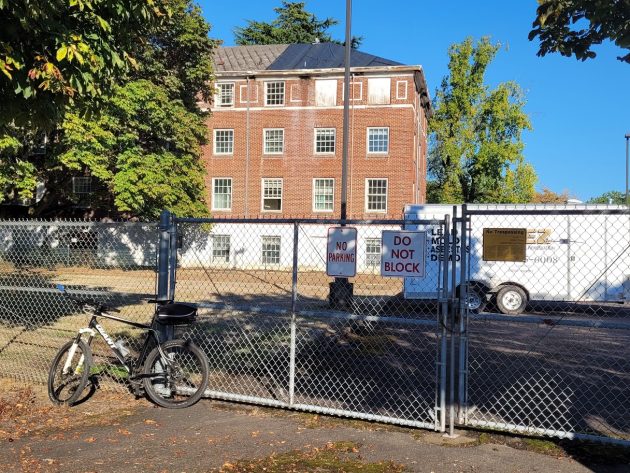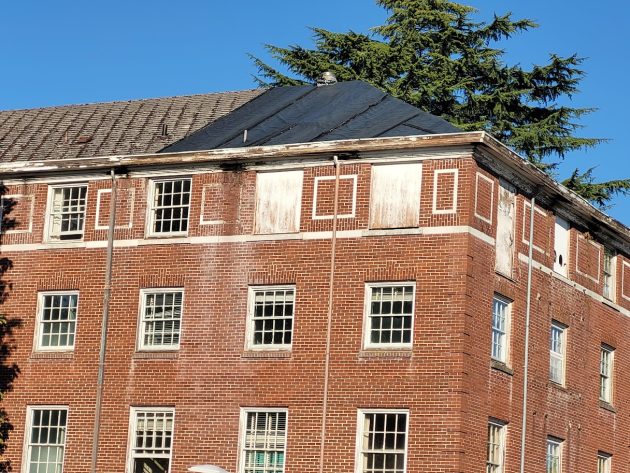
The view of Building B-2 at the former U.S. Bureau of Mines from the fence on Liberty Street on Oct. 5, 2024.
The U.S. Department of Energy intends to demolish an old building off Liberty Street, on the campus of the former U.S. Bureau of Mines. The question is why has this four-story office building been left to rot to the point that the government wants to tear it down.
In its 217-page environmental assessment, the Energy Department reports that the structure, known as Building B-2, has been vacant since the mid-1990s, and utilities such as water, power and gas have long been turned off.
There’s asbestos to deal with, maybe lead paint, along with dead birds in the attic, mold on some walls, and other problems. So why would a research lab operated by the federal government just abandon a building like that?
You may not remember, and I didn’t either until I went to the clippings in newspaper.com, but times were tough for the Bureau’s Albany Research Center in the 1990s. The Democrat-Herald reported on efforts by local officials and Congressman Peter DeFazio to keep the center’s appropriations from being slashed, but it didn’t work.
Congress abolished the Bureau of Mines in 1995. In Albany, this prompted obvious fears that the center would close.
It didn’t close but became, along with other Bureau labs, part of the fossil energy section of the U.S. Department of Energy. Now of course we call it the National Energy Technology Lab or NETL.
In 1995, the last year of the Bureau of Mines, the Albany center had nearly 130 employees and a budget of $9.5 million. By 1996, according to a newspaper story in April of that year, the staff was down to 83 and the budget was $5 million.
So, no wonder they didn’t need Building B-2. No wonder they had to save on expenses wherever possible. And that evidently led to the decision not to pay for utilities to keep the now empty four floors in B-2 heated and the roof patched enough to keep the rain out.
The building was constructed in 1875 and was moved to its present site in 1926, according to NETL. Until now though, when its demolition is likely, no one showed much interest in its preservation. Now the City of Albany and others have asked the Energy Department not to tear it down or to save artifacts if it is demolished..
The government’s comment period on the environmental assessment ran out last month. I asked NETL what happens now. The local contact listed on the environmental assessment referred me to Shelley Martin, the agency’s public affairs director in Morgantown, WV.
“Regarding the status of the building,” Martin emailed back, “NETL is informed by multiple factors and inputs and plans to make a final decision regarding B2 in 2025.”
So we won’t know the outcome for a while. But now, remembering what was going on around 1995, at least I have a good idea of why the building was allowed to run down. (hh)

Even from the street, you can see signs of the building’s deterioration since the 1990s.

ATEZ Environmental Remediation, a firm based in Harrisburg, evidently has been working at Building B-2.


So sad… I remember the beautiful grounds surrounding a beautiful building… such a waste of history!
If I remember right there was a big safety issue with the structure in the event of an earthquake. I doubt it will be saved as it isn’t usable for this reason.
A little off topic but I wonder if anyone remembers that there is a time capsule in bedded in the NE corner of B-1. You would think its existence and location would be recorded somewhere for future retrieval…
Such a failing by our government! Awful. I commented that it should be preserved during the comment period, because the 3-papers-a-week paper edition of the D-H ran the story.
I told you about that, Hasso, so I’m glad you followed up, even though it is too late. I’m sure not many comments were submitted, because no one but a few old farts like me takes the 3-papers-a-week D-H subscription.
This isn’t the only place on Federal property that has been allowed to deteriorate to the point of demolishing. Anyone who has relatives in the military will tell you they are often housed in “barracks” with similar conditions until they get so bad the DOD pays them extra to live off base so the buildings can be torn down.
Typical government attitude of non maintenance.
The NETL “old Building has a very interesting Albany history. In 1890 Albany Ladies Aid Society built this 2 story wooden frame as an orphanage/hospital for poor children. It was located on Goltra Street near present day Calioopia Middle school. In 1901 it was moved to 9th Ave (present day Central School site) for the beginning of Albany College. It was the women’s dormitory and called Tremont Hall, because you could see the Cascade Mts. from its top floor. When Albany College moved out to Queen and Broadway in 1926, it went also. It was then transformed with brick facing. In 1943 the Bureau of Mines purchased Albany College buildings and that same building became the headquarters of Henry Kroll and his zirconium production.
It does seem a waste without much recognition.
History is who we are. Thanks, Dave
I worked in the basement of building 2 from 1975 through the end of 1993 when I moved to a new research photographic lab in the basement of building 33. I was also responsible for all the photographic archives from the Albany Bureau of Mines beginning.
I’m sure many folks already know a lot about the historical connections of this building with the Albany College and connections with Walter and Thomas Montieth, as well as the Blain family and the orphanage – hospital.
But little known is the significant fact that Dr. Kroll had his first up-scale Zr reduction furnace built in the North end of building 2 that went all the way to the fourth floor (circa 1949). And Dr. Kroll’s office was in the SW corner of the fourth floor to keep tabs of the furnace runs.
In 1984 many buildings at the center were listed as listed as a Historical Landmark in the development of ductile zirconium where many of the brick structures were listed on the historic registry…except Bldg. 2
I had heard many stories from several of the old-timers that Dr. Kroll had built his first up-scale furnace in the North end of the building. But the team that had put the building documents together earlier on for the national historic site told me that they need more info to include bldg. 2 on the list.
Years later I found a 4×5” negative that apparently has gotten lost which clearly shows the first Zr furnace scale up! If I had showed them that photo back then I’m sure Bldg. 2 would have been include on that historical list. And you can even see in the photo the huge walnut tree through the top floor windows looking North to Bldg. 1.
So I guess devoting an entire building to a world renown Zr researcher like Dr. Kroll and his historically world first large Zr furnace doesn’t make sense as part of a significant part of Albany’s history. As Albany touts the fact that it has many unique Victorian homes it’s surprising no mention of the activity at the facility and its impact on the world.
Seems like I once read in the Albany Democrat Herald that this building was originally Albany College. Is this true or is my memory slipping?